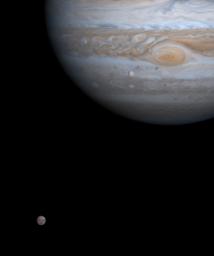
|
Europa and Callisto under the Watchful Gaze of Jupiter
- Click the image above for a larger view
- Full-Res JPEG (846 x 1016) (31.0 kB)
- Full-Res TIFF (846 x 1016) (728.0 kB)
Caption:
One moment in an ancient, orbital dance is caught in this color picture taken by NASA's Cassini spacecraft on Dec. 7, 2000, just as two of Jupiter's four major moons, Europa and Callisto, were nearly perfectly aligned with each other and the center of the planet.
The distances are deceiving. Europa, seen against Jupiter, is 600,000 kilometers (370,000 miles) above the planet's cloud tops. Callisto, at lower left, is nearly three times that distance from the cloud tops. Europa is a bit smaller than Earth's Moon and has one of the brightest surfaces in the solar system. Callisto is 50 percent bigger -- roughly the size of Saturn's largest satellite, Titan -- and three times darker than Europa. Its brightness had to be enhanced in this picture, relative Europa's and Jupiter's, in order for Callisto to be seen in this image.
Europa and Callisto have had very different geologic histories but share some surprising similarities, such as surfaces rich in ice. Callisto has apparently not undergone major internal compositional stratification, but Europa's interior has differentiated into a rocky core and an outer layer of nearly pure ice. Callisto's ancient surface is completely covered by large impact craters: The brightest features seen on Callisto in this image were discovered by the Voyager spacecraft in 1979 to be bright craters, like those on our Moon. In contrast, Europa's young surface is covered by a wild tapestry of ridges, chaotic terrain and only a handful of large craters.
Recent data from the magnetometer carried by the Galileo spacecraft, which has been in orbit around Jupiter since 1995, indicate the presence of conducting fluid, most likely salty water, inside both worlds.
Scientists are eager to discover whether the surface of Saturn's Titan resembles that of Callisto or Europa, or whether it is entirely different when Cassini finally reaches its destination in 2004.
Background Info:
Cassini is a cooperative project of NASA, the European Space Agency and the Italian Space Agency. The Jet Propulsion Laboratory, a division of the California Institute of Technology in Pasadena, manages the Cassini mission for NASA's Office of Space Science, Washington, D.C.
Cataloging Keywords:
| Name | Value | Additional Values |
|---|---|---|
| Target | Jupiter | Callisto, Europa, Titan |
| System | Jupiter | Saturn |
| Target Type | Planet | Satellite |
| Mission | Cassini-Huygens | Galileo, Voyager |
| Instrument Host | Cassini Orbiter | Galileo Orbiter |
| Host Type | Orbiter | Flyby Spacecraft |
| Instrument | Imaging Science Subsystem (ISS) | |
| Detector | ||
| Extra Keywords | Color, Crater, Impact, Moon, Water | |
| Acquisition Date | ||
| Release Date | 2000-12-21 | |
| Date in Caption | 2000-12-07 | |
| Image Credit | NASA/JPL/University of Arizona | |
| Source | photojournal.jpl.nasa.gov/catalog/PIA02861 | |
| Identifier | PIA02861 | |
